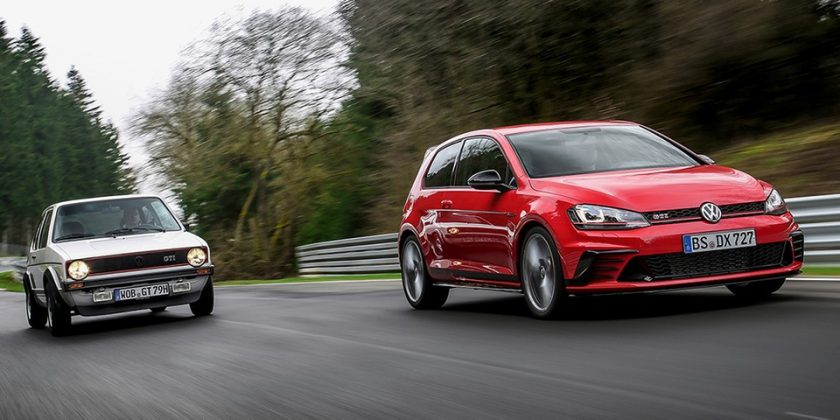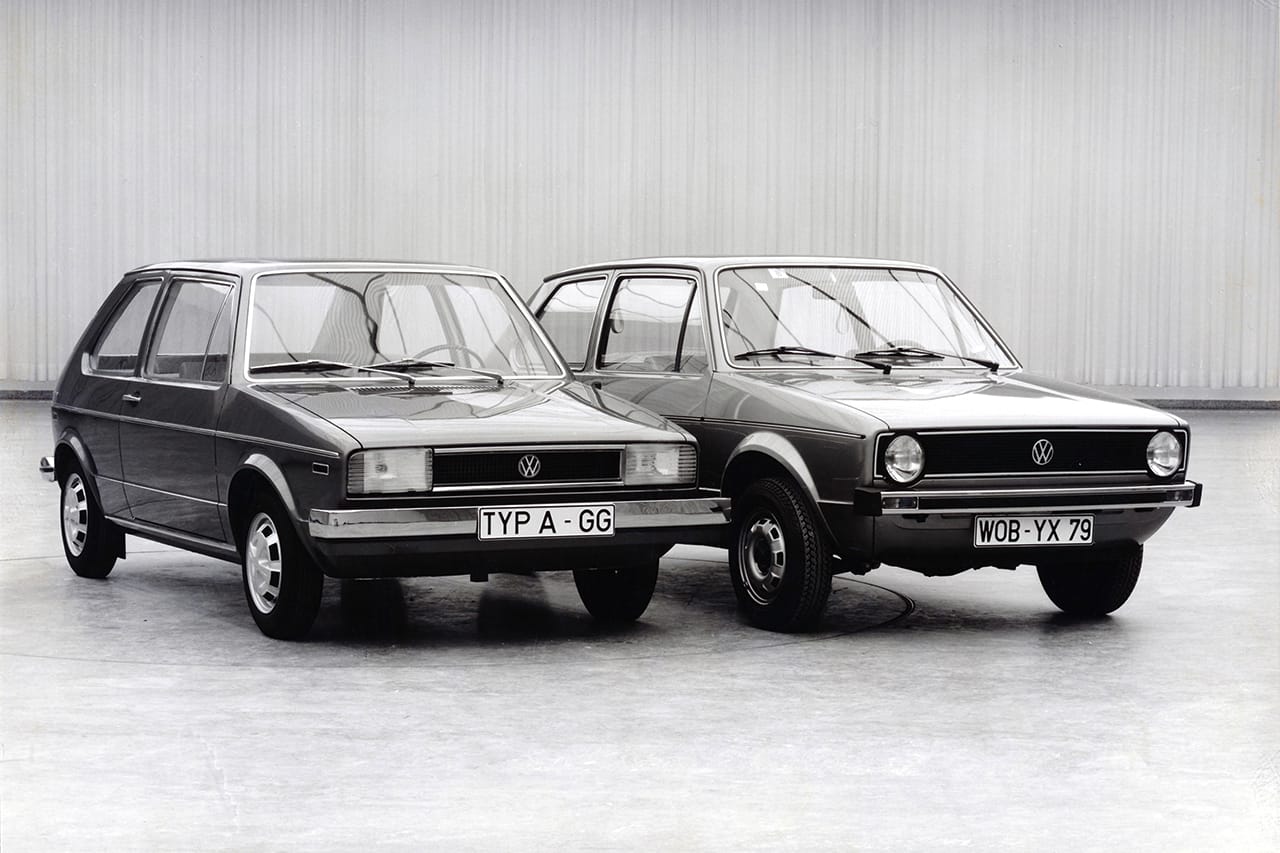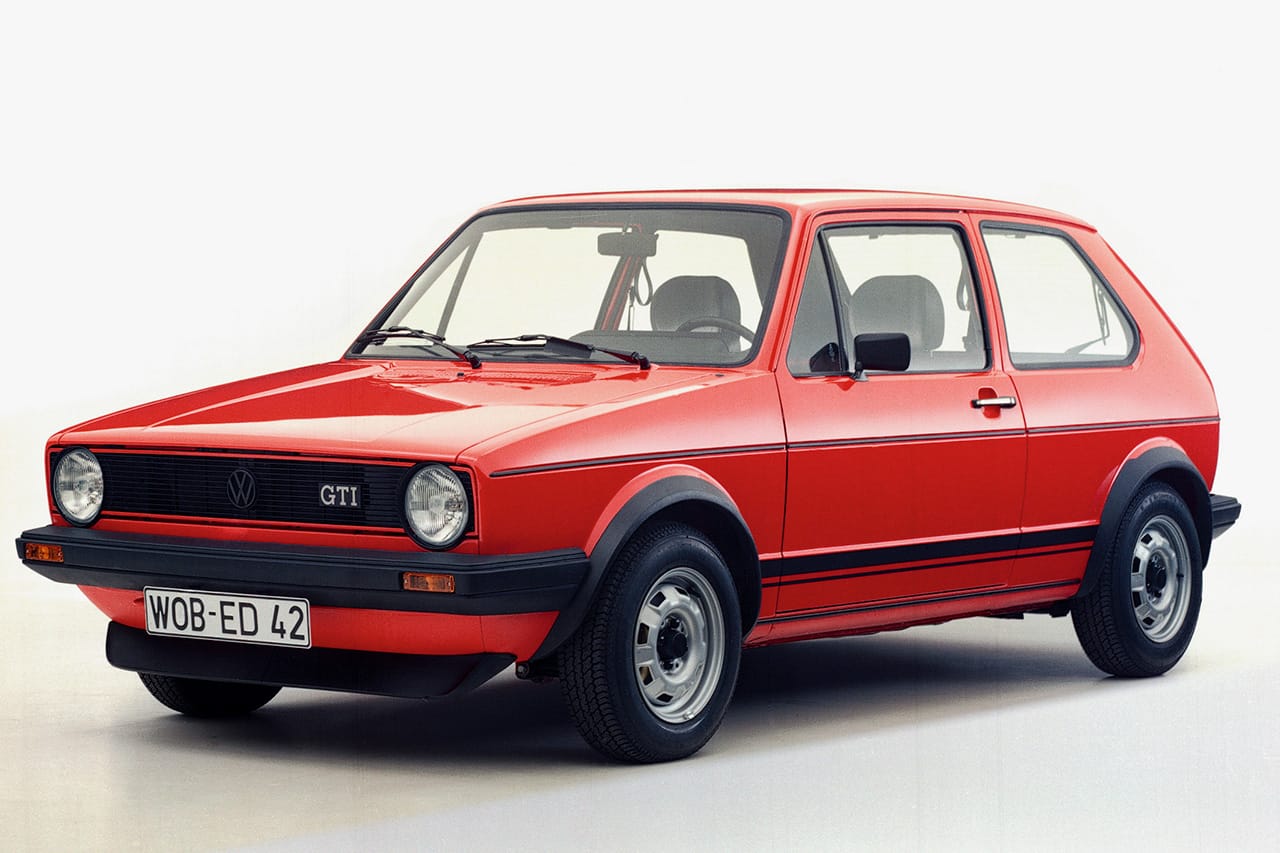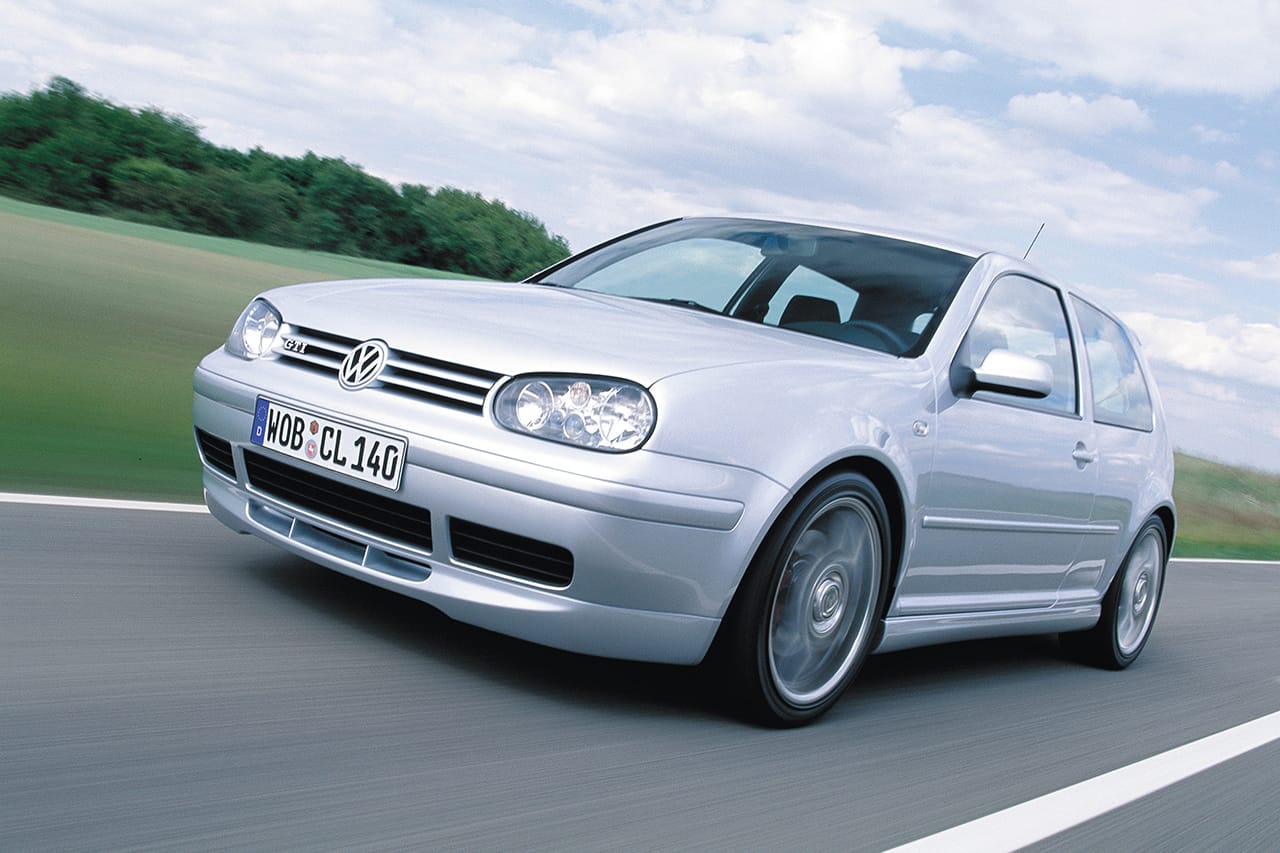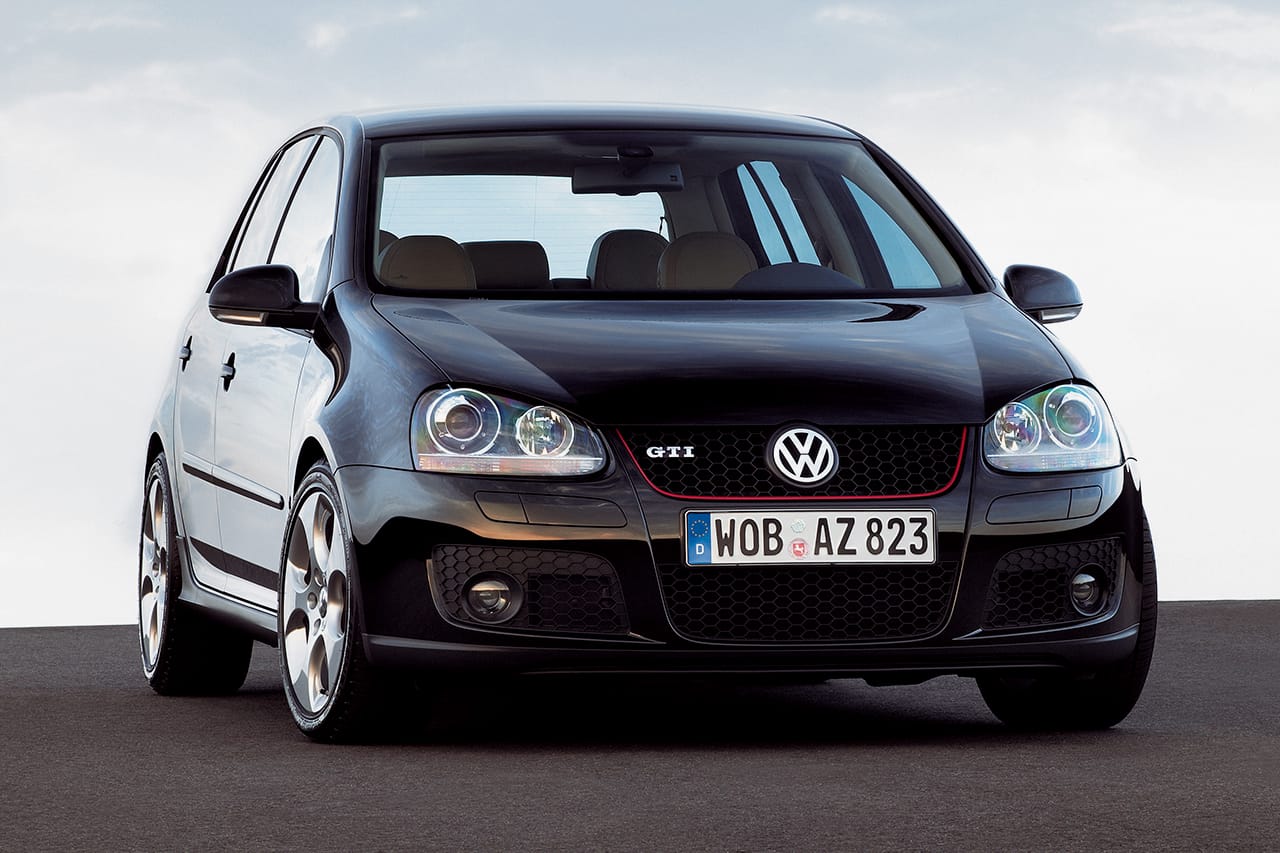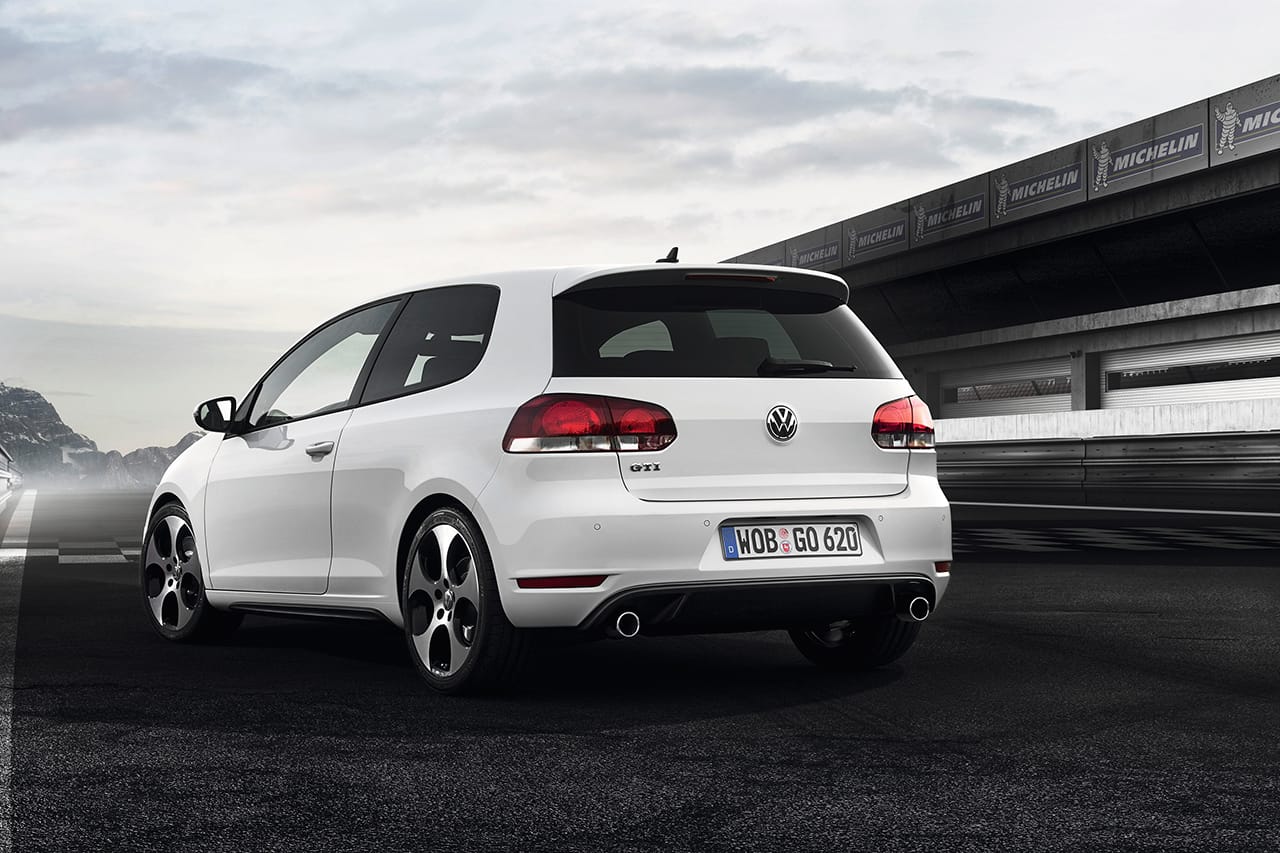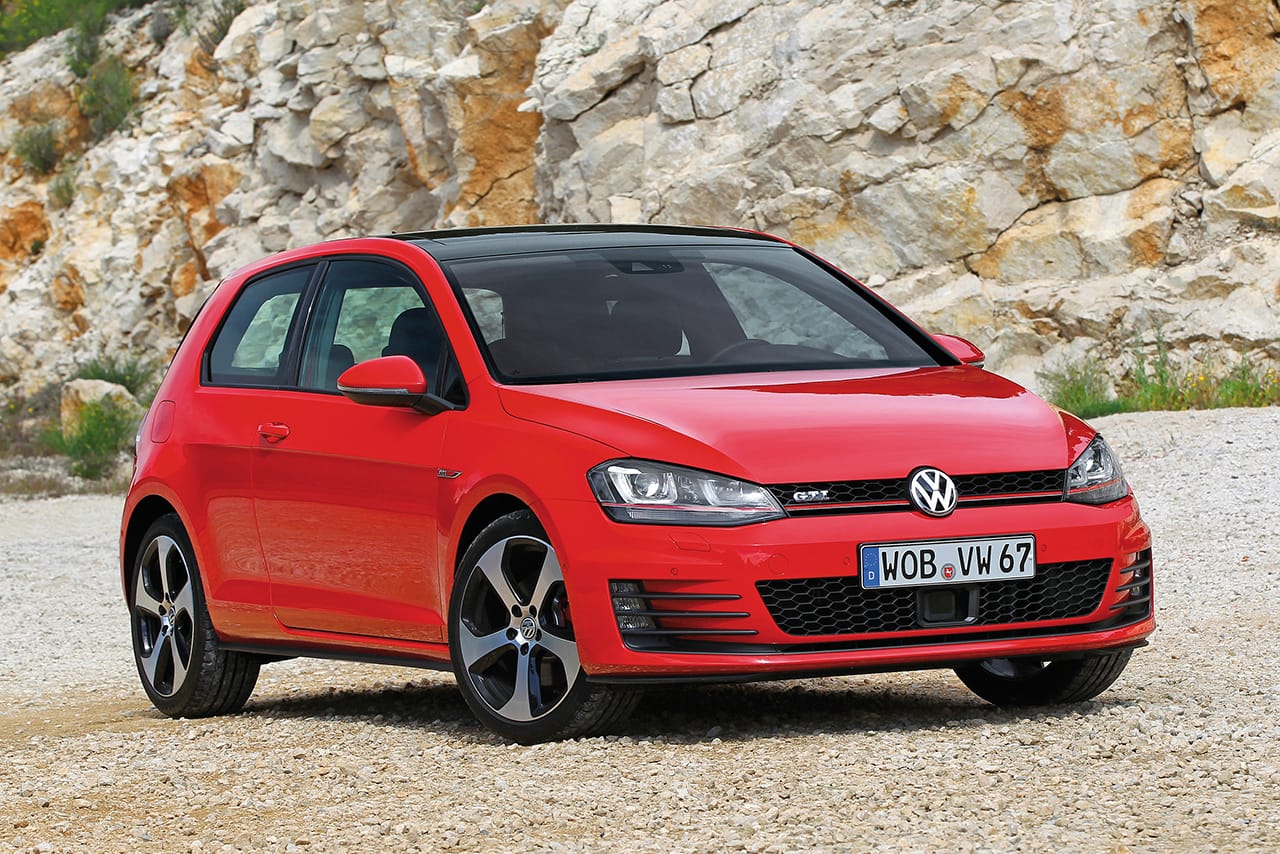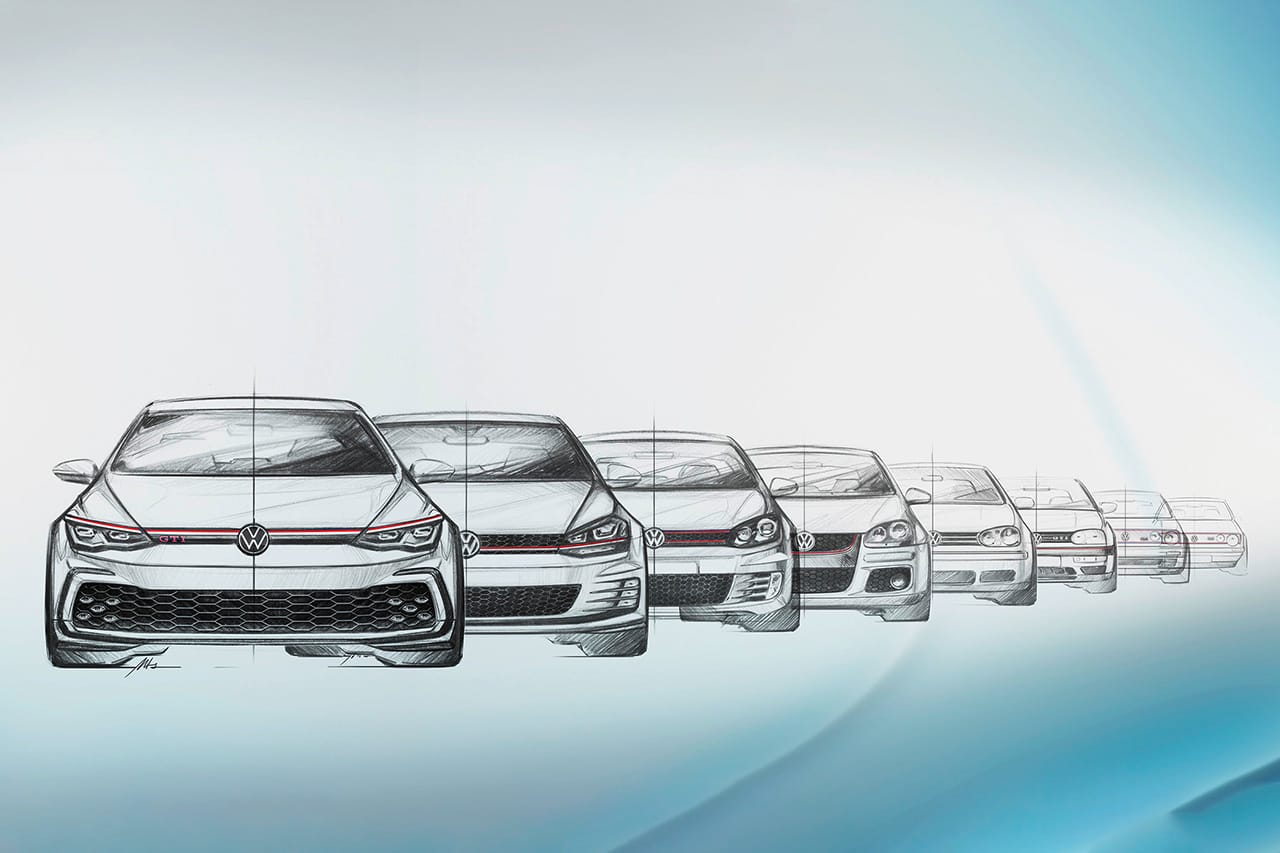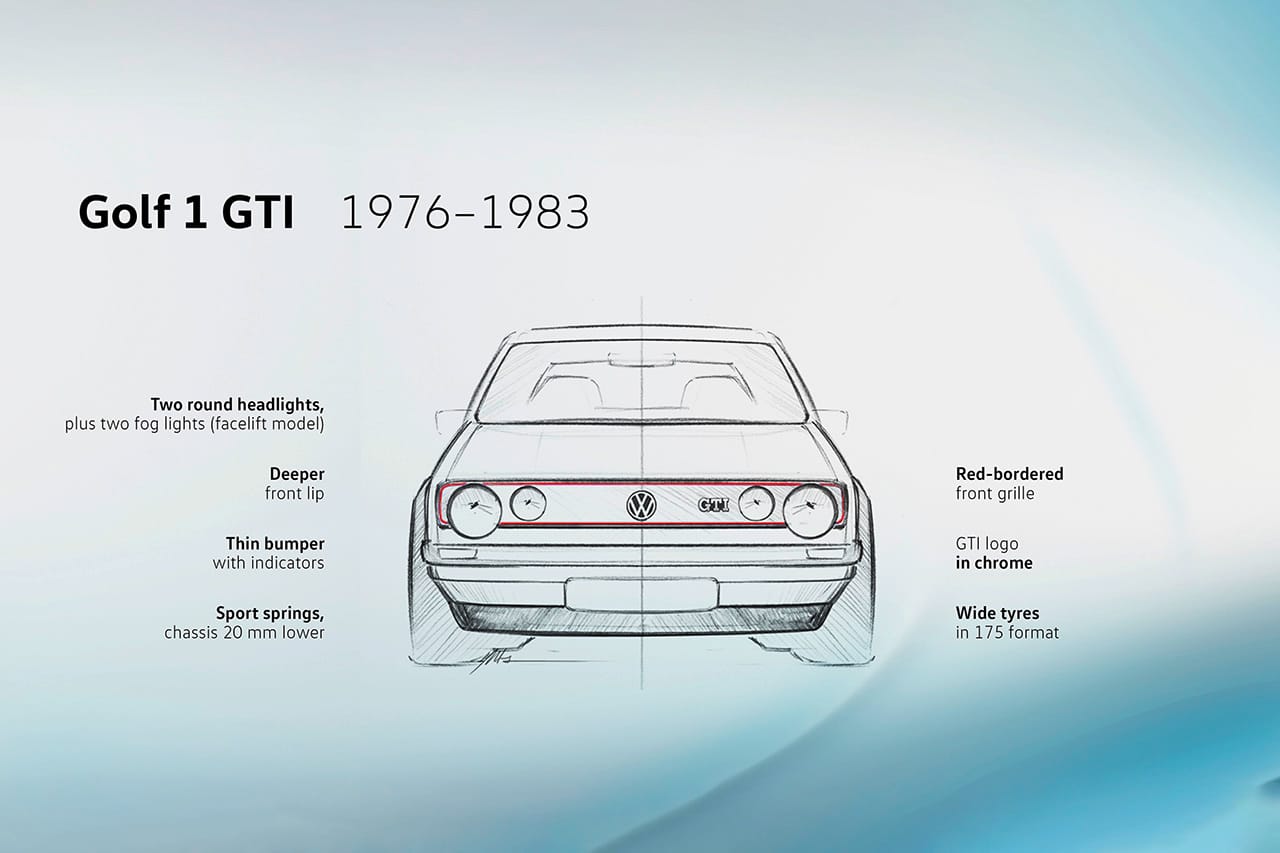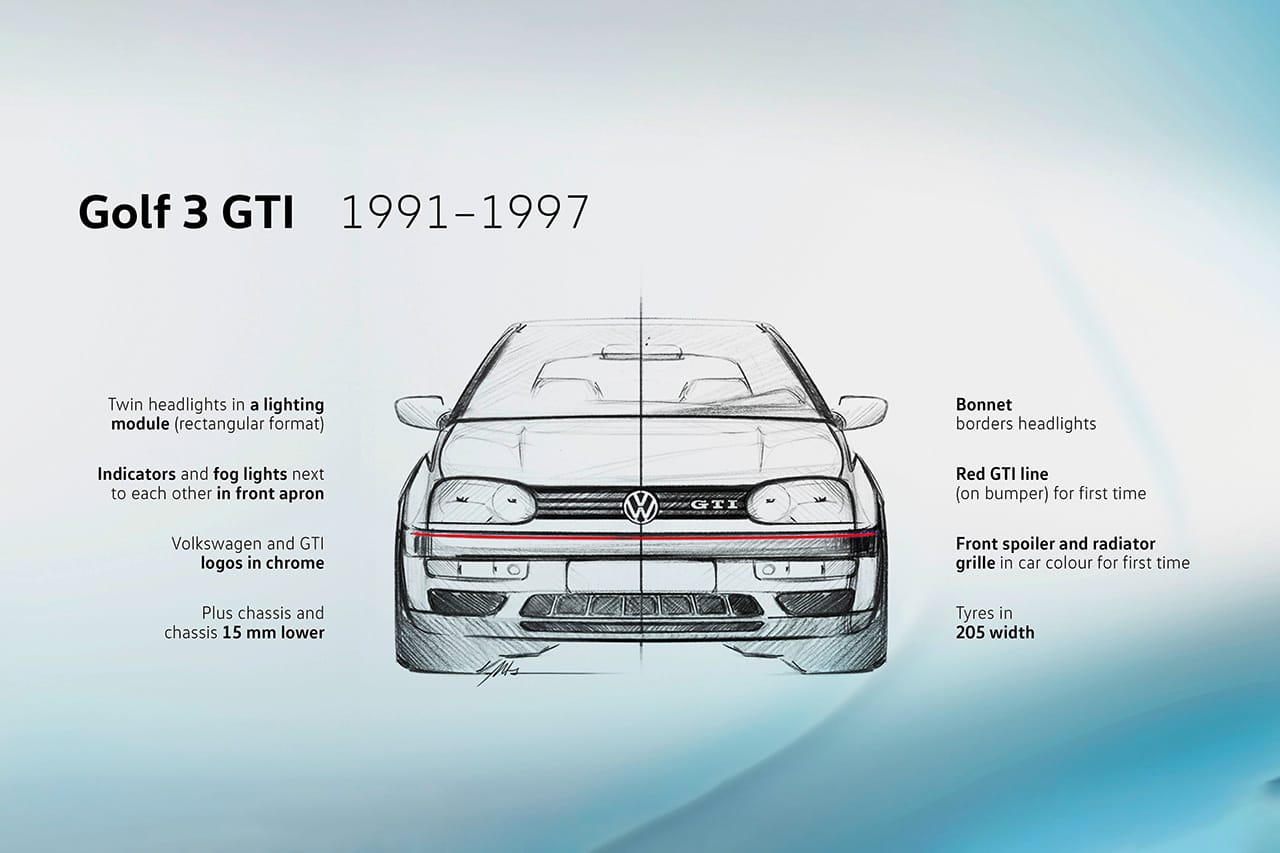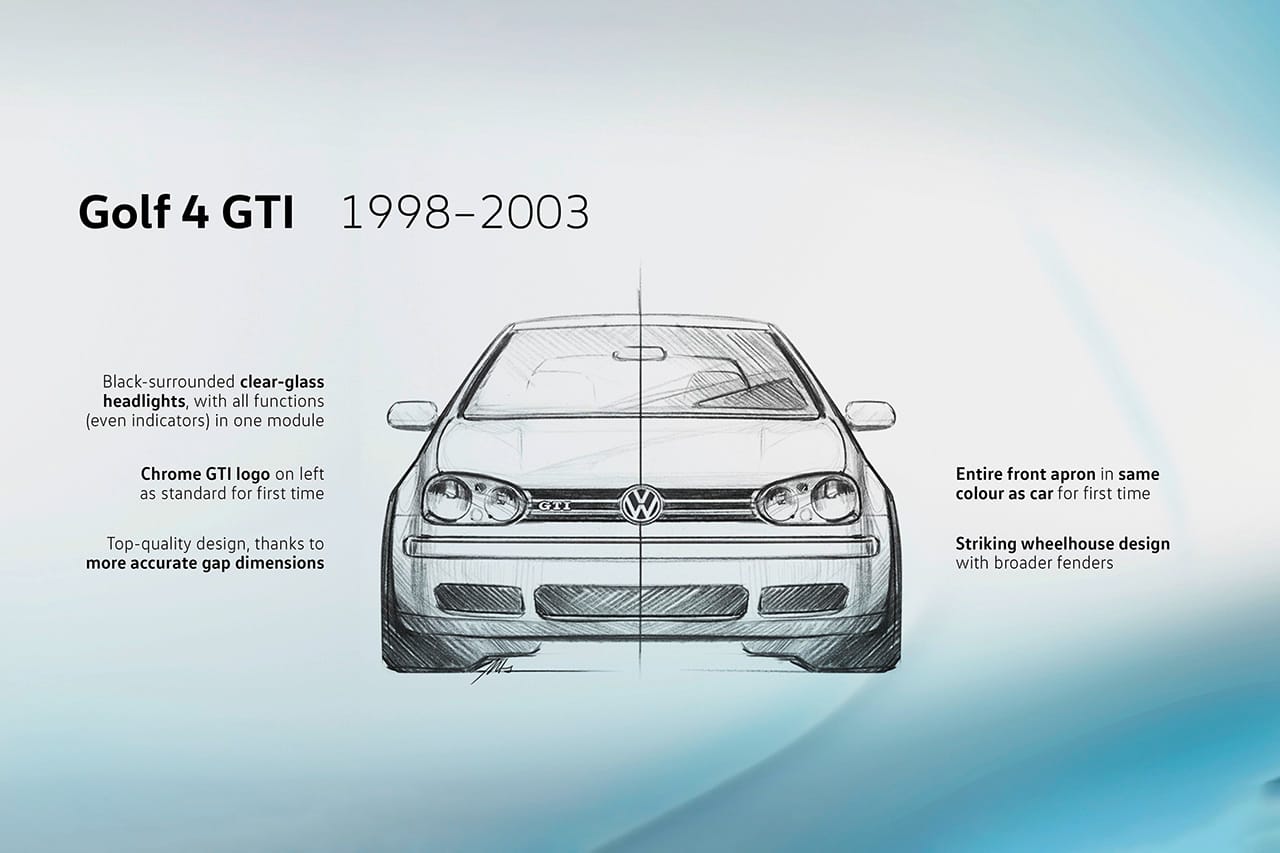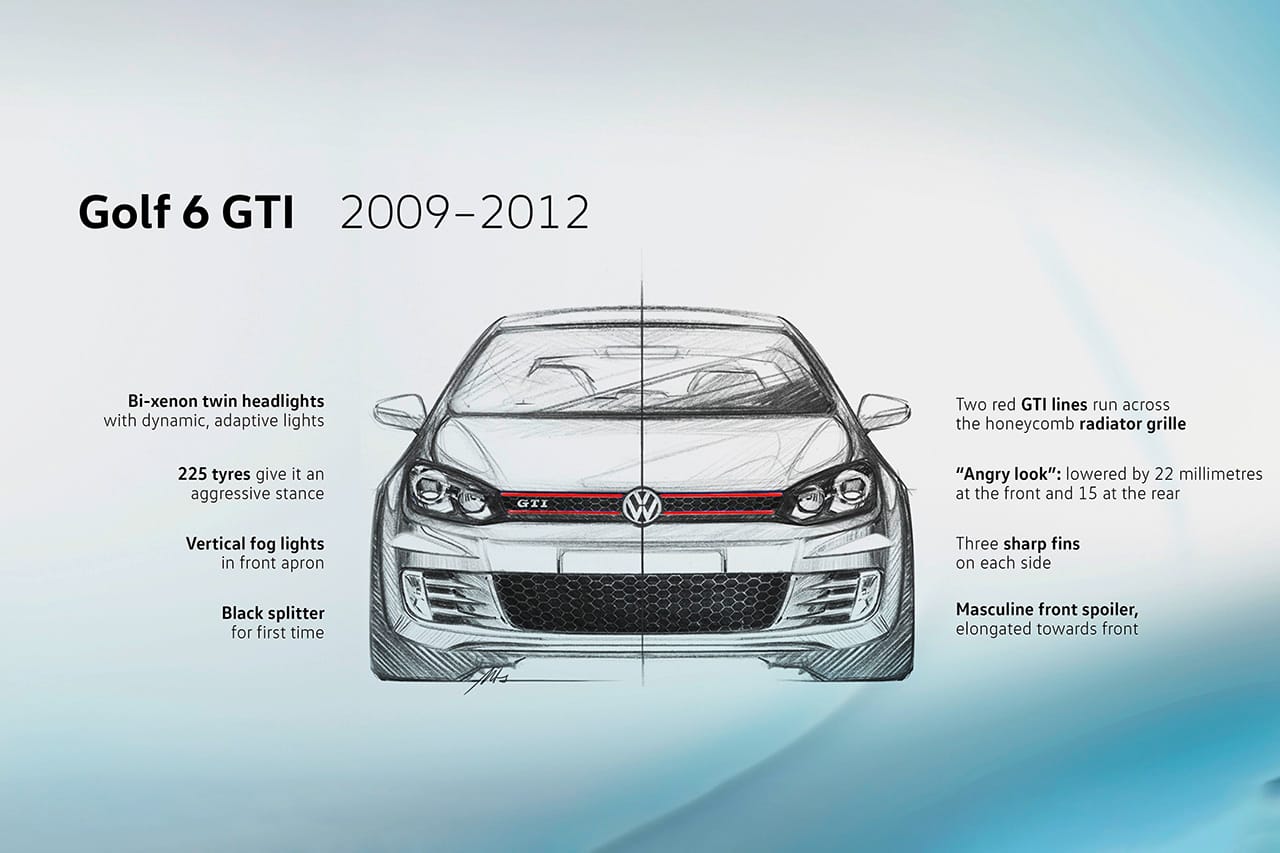In 1974, a hatchback was born. The Volkswagen Golf was the next flagship model for the marque following the Beetle’s 40-year run. It was designed to be an affordable replacement for the Beetle — Volkswagen translates to the “people’s car” after all — and was built for long-distance journeys capable of seating a family of five. Not only did the Golf meet these criteria, but it was also compelling enough to make Volkswagen build a faster, sports-derived version. In 1976, a hot hatchback was born.
The Volkswagen Golf GTI is the daddy of all hot hatchbacks, and to this day remains a benchmark in its field. Back in the ‘70s, if you wanted a fast but affordable car you’d opt for something small, and unreliably British — an MG MGB perhaps — but you’d definitely never opt for something German: a synonym for reliability, excellence, albeit not-budget-friendly.
Golf: draft design (left) and the series production version (right)Volkswagen Ag
Yet the VW Golf GTI offered all at an affordable price. It could seat your friends in the back, unlike a similarly-matched sportscar of the time; a GTI was a sports car that could do all of the boring, practical things, but faster.
Back in the ‘80s, opting for a Volkswagen Golf GTI was against the status quo. At the time many would have chosen from the hundreds of early ‘80s American, Japanese or British cars on offer. Today, however, if you’re looking for a hot hatchback it’s arguably wrong not to start with the Golf GTI. The Golf GTI is now in its eighth form, presenting more power, speed, and mass than any base-level GTI before.
History
Many think the Volkswagen Golf GTI is the original hot hatchback. Technically, it’s not: the title for “the ultimate hot hatch” is up for debate. Some believe it’s the 1973 Simca 1100TI, as the 105 mph top speed and 82 HP was quite the achievement for a small car of its time. Despite this, some enthusiasts would not count the Simca as the first hot hatch because the 1100TI never came to small fast-car havens such as the United Kingdom. It’s also debated whether the 1976 Renault 5 Gordini was the first hot hatch — the model was much more of what we’ve come to expect nowadays, with its racing pinstripes, widebody kit, flashes of red and its 1.4-liter, 92 HP engine.
Volkswagen Golf GTI MKIVolkswagen Ag
The Volkswagen Golf GTI MK1 was introduced just a few months after the Renault 5 Gordini in 1976. It was the first hot hatchback to prove that the formula for a front-engined, family-sized, small performance car worked, as it sold in the hundreds of thousands. 462,000 units, actually. Fifteen52 co-owner and life-long Volkswagen enthusiast Matt Crooke says, “Starting with the first Golf, VW set the bar for not only attention to detail, but also in performance and quality for what a small car should be.”
By the turn of the ‘80s, Volkswagen had dominated the small performance car market. First of all, the VW Golf GTI MK1 was instantly recognizable. Two buggy headlights, a boxy design, huge GTI badges, red grille trim, a golf-ball shift knob and those iconic tartan seats — it was a recipe for success. Today the design language is clear — elements from the first generation GTI can be found through the car’s legacy and within the current MKVIII design. Why fix something that isn’t broken?
The formula served as the perfect base for Generation X drivers looking to stand out. Crooke was one of those people. “When I was looking to purchase my first car at 16, all my friends were out street racing Honda Civics and Acura Integras,” he said. “It started as a kid, playing with toy VW Golfs… I never liked being part of the status quo.”
Compared to those cars favored by Crooke’s friends, the Golf GTI was a left-field option because it did not initially have the reputation of other cars designed for a younger audience. However, there is an unspoken — yet unrivaled — understanding in the car community that the Golf GTI is “the best” in its field. This was solidified with the MKII. The new model was bigger, faster, and as a result more desirable than the MKI. It produced 139 BHP in its most standard GTI form, and appeared in numerous variants — the more powerful twin-cam 16-valve, the all-wheel-drive Rallye G60 with a 160 BHP supercharged engine, the limited-to-70, 210 BHP Golf Limited, are just a few that are now incredibly sought-after.
Volkswagen Golf GTI MKIIVolkswagen Ag
Accounting for all of the versions, the MKII was one of the definitive cars of the 1980s. From the late ‘80s and into the mid-’90s, the U.K. car scene was dominated by hot hatchbacks because the boy racing scene was thriving, and Golfs were frequent exhibits. Like its predecessor, the MKII was once again a great platform for many looking to experiment with their new purchase. As Crooke notes, “Whether on the race track or at the car show scene, Volkswagen people are arguably the most progressive with their cars as well. Many current trends and styling cues have started in the VW scene.”
By 1992, Volkswagen had moved onto the lackluster MKIII Golf. This model could not hold the flame to the MKII, and subsequently, it never became something special. Perhaps the Golf was starting to show its age; its styling seemed outdated when the MKIII released, and it was bigger and heavier than the last model, too. Coupled with its not-so-impressive two-liter engine, there wasn’t much going for the MKIII GTI.
However, what the MKIII lacked in sportiness, it made up for in uniqueness. Oddities in the range include the Harlequin, a multicolored Golf inspired by a 1964 Volkswagen Beetle advertisement; the European Tour pack which honored Pink Floyd, the Rolling Stones, and Bon Jovi; as well as the Kamei Edition, which featured a full Kamei body kit.1 of 2
Volkswagen Golf GTI MKIIIVolkswagen Ag2 of 2
Volkswagen Golf GTI MKIVVolkswagen Ag
Volkswagen had lost its way with the Golf GTI when it introduced the MKIV in 1997. The GTI spec was an optional extra rather than a standalone car, which was a huge knock to the GTI purists and a disservice to the car’s legacy. Sure, it had the looks; the MKIV GTI was fitted with BBS rims, tinted rear lights, a GTI badge and Recaro seats, but the model never got the power it desperately needed. The only saving grace for the MKIV was the R32 — a VR6-powered, 237 BHP model that was often a poster child for hot hatchery served in “Deep Blue Pearl,” gracing the walls of pubescent millennials and their TV screen as they played Gran Turismo 4.
The Turning Point
In 2004, the sound of a turbocharged engine was music to enthusiasts’ ears. The classic had returned with full force, equipped with a turbo for the first time in its history.
The Volkswagen Golf GTI MKV was an homage to what the MKI brought — affordability, power, practicality and reliability. The MKV also made an impact in the car scene. “The VW Golf and GTI have always made a statement. It says, ‘I’m small, but I’m sophisticated…’ When you get into a VW Golf or GTI, it just feels right — it feels fun, and it feels a lot more expensive than it is,” says Crooke.
Inside the MKV, you’d find tartan cloth seats and a golf ball gear knob, just like the original. On the outside, VW added a red trim around the grille and gave the body a subtle, yet brutish design that channeled the energy of the MKI. It felt like the VW Golf GTI that had been missing for so long, with its low and wide body that exuded a commanding presence despite its small size.
Volkswagen Golf GTI MKVVolkswagen Ag
The MKV also came in a dizzying amount of versions. Like its predecessor, it also came as an R32, making near-as-makes-no-difference 250 BHP. With its four-wheel-drive system and a tech-heavy DSG gearbox, the model could do 0-62 MPH in just 6.2 seconds. Big figures for a small yet mighty car.
Then there was the GTI Edition 30, which was a homologation model marking the GTI’s 30th anniversary. Volkswagen also produced the GTI Speed Edition, which took colors from Lamborghini’s swatch card and added it to the MKV, as the Volkswagen Group owns Lamborghini, along with Audi, Bentley, Bugatti and Porsche.
Volkswagen also explored the future of hot hatchbacks with the GTI W12-650 concept. This unique experiment was more of an exercise in what the VW Group could achieve with all the brands it had at its disposal. It featured the six-liter W12 bi-turbo engine from the Bentley Continental GT delivering 650 HP, the front brakes from the Audi RS4, the rear brakes and an axle from a Lamborghini Gallardo. Although it never went any further than a concept project, it did show what the company — and the GTI platform — was capable of.
2008 saw the release of the MKVI, coming to the market with minor updates such as a slightly modernized look and a power increase from 197 HP to 208 HP. However, it served as the base for the now formidable Golf R — not just one of the best hot hatchbacks in its field, but also a supercar slayer. The MKVI Golf R was the replacement for the previous R32. It packed a 270 HP four-cylinder engine, all-wheel-drive, and could hit 62 MPH in 5.5 seconds. For reference, a 2009 Ford Mustang GT hit the same speed in 5.3 seconds. 1 of 2
Volkswagen Golf GTI MKVIVolkswagen Ag2 of 2
Volkswagen Golf GTI MKVIIVolkswagen Ag
The Golf R (MKVI, MVII and MKII.5) have become a tuner’s paradise; there are ways to get 500 HP from it without having to break the bank, “or the engine,” as this Revo article states. VW itself has even teased the potential 400-plus BHP Golf R Plus, knowing full-well it’d sell in a climate of rivals filled with Mercedes-Benz AMG A45s and Audi RS3s pumping out 415 BHP and 400 BHP respectively.
The 2000s was a turning point for Volkswagen. VW had found the GTI’s legacy and pedigree again. By the time the almighty Golf R arrived, VW had regained its crown as the definitive hot hatch manufacturer — although other cars are quicker (an Audi RS3, perhaps), and some are even cheaper (Ford Focus RS, Renault Megane R.S.), nothing could evoke the nostalgia or the energy of Golf GTI. Today, fans partly relive their childhood dream, as many missed out on being able to get a super-Golf back in the day before they went out of production. Crooke also notes, “With various trim levels and now the R models, you can have an electric Golf, a diesel Golf, an adventure wagon Golf, or even an all-wheel-drive-as-fast-as-a-Ferrari Golf right off the showroom floor… The guy driving the base model has pride, knowing that he can work his way up to that halo vehicle that, in the end, is still a Golf.” No matter what specification your Golf is, it’s owning a piece of history that counts.
How to Get One
To this day, the now-16-year-old Volkswagen Golf GTI MKV is revered as the best new-century GTI around, and is the one to get as a daily driver. Prices are affordable — a clean but fairly-used example will set you back around £6,000 GBP (approximately $7,700 USD), while models like the Edition 30 could cost almost £13,000 GBP (approximately $16,750 USD). However, if you look after your GTI, it could become a modern classic and be a good investment like GTIs of yesteryear — take a look at this £18,000 GBP (approximately $23,000 USD) MKI for example.
Rumor has it that one Golf has been sold every 41 seconds since 1978, so getting your hands on a GTI won’t be a hassle. However, there are a few major differences between certain models that mean your $5,000 USD budget might need to be expanded. For example, “Water-cooled VWs are becoming highly collectible, [and] air-cooled VWs have always been desirable,” says Crooke, which is sure to drive up the price. 1 of 9
Volkswagen Golf GTI LineageVolkswagen Ag2 of 9
Volkswagen Golf GTI MKIVolkswagen Ag3 of 9
Volkswagen Golf GTI MKIIVolkswagen Ag4 of 9
Volkswagen Golf GTI MKIIIVolkswagen Ag5 of 9
Volkswagen Golf GTI MKIVVolkswagen Ag6 of 9
Volkswagen Golf GTI MKVVolkswagen Ag7 of 9
Volkswagen Golf GTI MKVIVolkswagen Ag8 of 9
Volkswagen Golf GTI MKVIIVolkswagen Ag9 of 9
Volkswagen Golf GTI MKVIIIVolkswagen Ag
On the flip side, Crooke also says, “Anyone with an average-Joe paycheck could grab an ‘83 or ‘84 GTI and fit right in with the other cream of the crop Euro sports cars of that period.” This might have something to do with there being 35,000,000 Golfs produced, but mostly, it’s because many have seen better days.
For example, this well-driven 1983 VW Golf GTI MK1 sold for $2,550 USD, while others such as this completely overhauled 1983 MK1 complete with a new turbocharger kit sold for $38,000 USD. Highly desirable versions of the MKII often fetch around $17,000 USD, while other models from that era onwards seldom ask for much more than $10,000 USD — unless it’s a far newer model.
The Future
The Golf GTI’s future is looking diverse. The current model, the MKVIII, has only just been released and comes as a GTI, GTD and GTE, which combined are set to account for more than 15 percent of all Golf sales in Europe because the car is simply that popular.
Volkswagen Golf GTI MKVIIIVolkswagen Ag
With all due respect, the MKVIII looks a bit pedestrianized, a bit — safe. Compared to the sharper and aggressive styling cues we saw with the previous generations, this model seems to look more towards the curvaceous nature found with the MKIII and IV Golf. It doesn’t have the same presence as those that came before it.
What is exciting, however, is the upcoming Golf R. Its MKVIII curvature has been squashed and tweaked to give the model a fittingly angry aesthetic, complete with quad tailpipes, spoilers, splitters, and more aerodynamic bits to make it look like the super hot hatch it truly is. Only time will tell if Volkswagen will have another MKV moment, when history repeats itself and the formula of a hot hatch is perfected once again.
Source: Read Full Article
